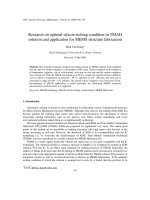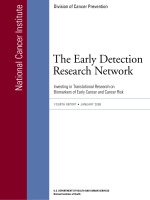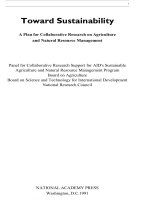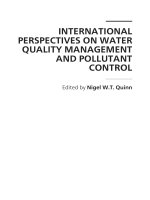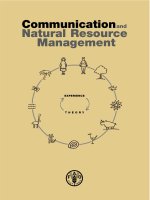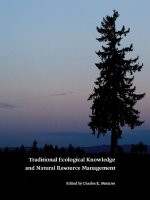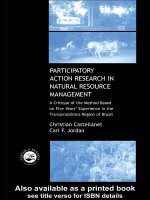INTERNATIONAL RESEARCH ON NATURAL RESOURCE MANAGEMENT: ADVANCES IN IMPACT ASSESSMENT docx
Bạn đang xem bản rút gọn của tài liệu. Xem và tải ngay bản đầy đủ của tài liệu tại đây (2.93 MB, 289 trang )
INTERNATIONAL RESEARCH ON NATURAL RESOURCE
MANAGEMENT
ADVANCES IN IMPACT ASSESSMENT
This page intentionally left blank
INTERNATIONAL RESEARCH ON
NATURAL RESOURCE
MANAGEMENT: ADVANCES IN
IMPACT ASSESSMENT
Edited by
H. Waibel
Institute of Development and Agricultural Economics
Faculty of Economics and Management
Leibniz University of Hannover
Germany
and
D. Zilberman
Department of Agricultural and Resource Economics
University of California at Berkeley
USA
Published by CABI
On behalf of the Science Council of the
Consultative Group on International Agricultural Research
CABI is a trading name of CAB International
CABI Head Office CABI North American Office
Nosworthy Way 875 Massachusetts Avenue
Wallingford 7th Floor
Oxfordshire OX10 8DE Cambridge, MA 02139
UK USA
Tel: +44 (0)1491 832111 Tel: +1 212 726 6490
Fax: +44 (1)1491 833508 Fax: +1 212 686 7993
E-mail: E-mail:
© FAO and CAB International 2007. All rights reserved. No part of this publication may be
reproduced in any form or by any means, electronically, mechanically, by photocopying, recording
or otherwise, without the prior permission of the copyright owners.
Library of Congress Cataloging-in-Publication Data
International Research on Natural Resource Management: advances in impact assessment / edited by
Herman Waibel & David Zilberman.
p. cm.
Includes bibliographical references and index.
ISBN 978-1-84593-283-1 (alk. paper) ISBN 978-1-84593-284-8 (ebook : alk. paper)
1. Consultative Group on International Agricultural Research. 2. Natural resources
Management Research. I. Waibel, Herman, 1951- II. Zilberman, David, 1947- III. Title.
S946.147 2007
338.1 dc22
2007008079
A catalogue record for this book is available from the British Library, London, UK.
Published jointly by CAB International and FAO.
Food and Agriculture Organization of the United Nations (FAO)
Viale delle Terme di Caracalla, 00100 Rome, Italy
Web site: www.fao.org
ISBN-13: 978 1 84593 283 1
The designations employed and the presentation of material in this publication do not imply the
expression of any opinion whatsoever on the part of the Food and Agriculture Organization of the
United Nations concerning the legal status of any country, territory, city or area or of its authorities,
or concerning the delimitation of its frontiers or boundaries.
The designations 'developed' and 'developing' economies are intended for statistical convenience
and do not necessarily express a judgement about the stage reached by a particular country, territory
or area in the development process.
The views expressed herein are those of the authors and do not necessarily represent those of the
Food and Agriculture Organization of the United Nations.
All rights reserved. Reproduction and dissemination of material in this information product for edu-
cational or other non-educational purposes are authorized without any prior written permission
from the copyright holders provided the source is fully acknowledged. Reproduction of material in
this information product for resale or other commercial purposes is prohibited without written per-
mission of the copyright holder. Applications for such permission should be addressed to the Chief,
Publishing Management Service, Information Division, FAO, Viale delle Terme di Caracalla, 00100
Rome, Italy or by e-mail to
Typeset by MRM Graphics Ltd, Winslow, Bucks
Printed and bound in the UK by Biddles, Kings Lynn.
Contributors vii
Foreword ix
H. Gregersen and J.G. Ryan
Acknowledgements xi
Acronyms and Abbreviations xii
Tables and Figures xv
Part I: Introduction
1 Why Natural Resource Management Research? 1
D. Zilberman and H. Waibel
2 The History of Natural Resource Management Research in the
CGIAR 12
H. Gregersen and T. Kelley
3 Productivity Enhancement and Natural Resource Management 21
D. Zilberman and H. Waibel
Part II: Natural Resource Management Case Studies: What Do They
Tell Us?
4 Natural Resource Management Case Studies: Overview and
Summary 56
H. Waibel and D. Zilberman
5 CIMMYT. Assessing the Impact of Natural Resource
Management Research: the Case of Zero Tillage in
India's Rice–Wheat Systems 68
V. Laxmi, O. Erenstein and R.K. Gupta
Contents
v
6 CIAT. Impact of Participatory Natural Resource Management
Research in Cassava-based Cropping Systems in Vietnam and
Thailand 91
T.J. Dalton, N.K. Lilja, N. Johnson and R. Howeler
7 WorldFish Centre. Impact of the Development and
Dissemination of Integrated Aquaculture–Agriculture
Technologies in Malawi 118
M. Mohan Dey, P. Kambewa, M. Prein, D. Jamu, F.J. Paraguas,
D.E. Pemsl and R.M. Briones
8 World Agroforestry Centre. Impacts of Improved Tree Fallow
Technology in Zambia 147
O.C. Ajayi, F. Place, F. Kwesiga and P. Mafongoya
9 ICARDA. Ex post Impact Assessment of Natural Resource
Management Technologies in Crop–Livestock Systems in Dry
Areas of Morocco and Tunisia 169
K. Shideed, V. Alary, A. Laamari, A. Nefzaoui and M. El Mourid
10 IWMI. Assessing the Outcome of IWMI's Research and
Interventions on Irrigation Management Transfer 196
M.A. Giordano, M. Samad and R.E. Namara
11 CIFOR. The Sustainability of Forest Management: Assessing
the Impact of CIFOR Criteria and Indicators Research 217
M.J. Spilsbury
Part III: Lessons Learned and the Way Ahead
12 The Major Lessons from the Case Studies 246
H. Waibel, D. Zilberman, H. Gregersen and T. Kelley
13 The Way Ahead – Impact Assessment of Natural Resource
Management Research 259
D. Zilberman, H. Waibel, T. Kelley and H. Gregersen
Index 267
vi Contents
Ajayi, Oluyede C., World Agroforestry Centre, Lilongwe, Malawi.
Alary, Véronique, CIRAD-Emvt/International Centre for Agricultural
Research in the Dry Areas (ICARDA), Tunis, Tunisia.
Briones, Roehlano M., Department of Economics, Ateneo de Manila
University, Philippines.
Dalton, Timothy J., Department of Resource Economics and Policy,
University of Maine, Orono, Maine, USA.
Dey, Madan M., WorldFish Centre, Penang, Malaysia.
Erenstein, Olaf, International Maize and Wheat Improvement Centre
(CIMMYT), India Rice/Wheat Consortium, Pusa Campus, New Delhi,
India.
Giordano, Meredith A., International Water Managment Institute (IWMI),
Colombo, Sri Lanka.
Gregersen, Hans, Standing Panel on Impact Assessment (SPIA) Chair
Emeritus, USA.
Gupta, Raj K., International Maize and Wheat Improvement Centre
(CIMMYT), India Rice/Wheat Consortium, Pusa Campus, New Delhi,
India.
Howeler, Reinhardt, International Centre for Tropical Agriculture (CIAT),
Bangkok, Thailand.
Jamu, Daniel, WorldFish Centre, Zomba, Malawi.
Johnson, Nancy, International Centre for Tropical Agriculture (CIAT),
Cali, Colombia.
Kambewa, Patrick, Department of Economics, Chancellor College,
Zomba, Malawi.
Kelley, Timothy, Science Council, Food and Agriculture Organization of
the United Nations (FAO), Rome, Italy.
Kwesiga, Freddie, Africa Challenge Programme, Forum for Agricultural
Research in Africa (FARA) PMB CT173, Accra, Ghana.
Laamari, Abdelali, Institut National de la Recherche Agronomique
(INRA), Settat, Morocco.
Laxmi, Vijay, Indira Gandhi Institute of Development Research (IGIDR),
Mumbai, India.
Lilja, Nina K., Consultative Group on International Agricultural Research
(CGIAR) Systemwide Programme on Participatory Research and
Gender Analysis.
Mafongoya, Paramu, World Agroforestry Centre, Lilongwe, Malawi.
vii
Contributors
El Mourid, Mohammed, International Centre for Agricultural Research in
the Dry Areas (ICARDA), Tunis, Tunisia.
Namara, Regassa E., International Water Management Institute (IWMI),
Colombo, Sri Lanka.
Nefzaoui, Ali, Laboratoire des Productions Animale et Fourragére,
Institut National de la Recherche Agronomique de Tunisie (INRAT),
Tunisia.
Paraguas, Javien, WorldFish Centre, Penang, Malaysia.
Pemsl, Diemuth E., WorldFish Centre, Penang, Malaysia.
Place, Frank, World Agroforestry Centre, Nairobi, Kenya.
Prein, Mark, WorldFish Centre, Penang, Malaysia.
Samad, Madar, International Water Managment Institute, Colombo, Sri
Lanka.
Shideed, Kamel, International Centre for Agricultural Research in the Dry
Areas (ICARDA), Tunis, Tunisia.
Spilsbury, Michael J., Centre for International Forestry Research (CIFOR),
Bogor, Indonesia.
Waibel, Hermann, Institute of Development and Agricultural Economics,
Faculty of Economics and Management, Leibniz University of
Hannover, Germany.
Zilberman, David, Department of Agricultural and Resource Economics,
University of California at Berkeley, USA.
viii Contributors
Investment in agriculture-related natural resource management research
(NRMR) has increased significantly over the last two decades; and so have
requests from the investors to assess the impacts of their past investments
in such research. The Consultative Group on International Agricultural
Research (CGIAR) is not an exception, and in 2003 a formal request was
made to the Chair of the CGIAR Science Council's Standing Panel on
Impact Assessment (SPIA). The request was a response to previously
voiced concerns regarding the dearth of documented credible evidence
that CGIAR NRMR is contributing to mission-level impacts on a wide
scale (see e.g. Raitzer, 2003; World Bank/OED, 2003; Kelley and
Gregersen, 2005). SPIA responded with an initiative that involved several
elements, including a number of case studies of CGIAR NRMR impact
assessment and further development of methods for NRMR impact assess-
ment.
This book presents the outcome of the SPIA initiative. It presents
seven case studies detailing the assessment of the impacts of some major
NRMR projects undertaken by the CGIAR. The case studies went through
a number of stages of review and revision, and the final, peer-reviewed
cases are presented in this book. Some of them, in a longer and more
detailed form, have already been published by the Centres involved; they
are referenced in the book.
The other thrust of the initiative dealing with research methodology
development involved input from an internationally recognized natural
resource economist, Professor David Zilberman from the University of
California, Berkeley, USA. Dr Zilberman also served as co-editor of the
present book. He has provided critical guidance on this part of the initia-
tive as well as on the case studies. Retired SPIA member, Dr Hermann
Waibel, is the other co-editor and also a recognized expert in the field.
ix
Foreword
SPIA thanks both of these individuals for their efforts to make this a suc-
cessful and useful initiative. A special vote of thanks goes to Professor
Waibel, now retired from SPIA, who for 4 years acted as the SPIA point
person on the project and was the main contact with the case study teams.
The SPIA initiative and the book benefited from the input and
involvement of many individuals in addition to Professors Waibel and
Zilberman. Thus, we also thank the following persons: centre case study
leaders Nancy Johnson and Tim Dalton (International Centre for Tropical
Agriculture), Mike Spilsbury (Centre for International Forestry Research),
Vijay Laxmi Pandey and Olaf Erenstein (International Maize and Wheat
Improvement Centre), Kamel Shideed and Véronique Alary (International
Centre for Agricultural Research in the Dry Areas), Meredith Giordano
(International Water Management Institute), Olu Ajayi and Frank Place
(World Agroforestry Centre) and Madan Dey and Patrick Kambewa
(WorldFish Centre). We thank former Science Council and SPIA
members, Alain deJanvry and Dick Harwood, and current members,
Flavio Avila, Mywish Maredia and Prabhu Pingali, and especially
Science Council Secretariat staff Tim Kelley and Ruben Echeverria, SPIA
consultant David Raitzer, and Sam Fujisaka and Doug White, who wrote
an insightful piece on the state-of-the-art of NRMR impact assessment in
the CGIAR; and we also thank Adel El Beltagy and Joachim Voss who
interacted with us throughout the initiative. Finally, we want to thank the
four anonymous peer reviewers who diligently reviewed the seven case
studies and provided the case study teams with insightful and useful sug-
gestions.
H.M. Gregersen
Past Chairman
SPIA
J.G. Ryan
Chairman
SPIA
References
Kelly, T.G. and Gregson, H. (2005) Lessons from CGIAR Impact Assessment Research. In:
Shiferaw, B., Freeman, H.A. and Swinton, S. (eds) Natural Resource Management in
Agriculture: Methods for Assessing Economic and Environmental Impacts. CAB
International, Wallingford, UK, pp. 341–360.
Raitzer, D.A. (2003) Benefit-Cost Meta-Analysis of Investment in the International
Agricultural Research Centres of the CGIAR. SC Secretariat, Rome.
World Bank (2003) The CGIAR at 31: An Independent Meta-Evaluation of the CGIAR,
Volume 1. Overview Report Operations Evaluation Department (OED), World Bank,
Washington DC, p. 46.
x Foreword
As the editors we are indebted to many people who helped to finish this
book. Foremost there are th ose from the Consultative Group on
International Agricultural Research (CGIAR) Science Council's Standing
Panel on Impact Assessment (SPIA), including former SPIA chair Hans
Gregersen and current chair Jim G. Ryan, for their wisdom and guidance,
the secretary and man behind the scene Tim Kelley for his extremely
valuable constructive criticism, and CGIAR Science Council Executive
Director and former SPIA member Ruben Echeverria. We also want to
thank the authors of the case studies who always responded positively to
our suggestions and criticism.
The book also benefited from several workshops on this topic,
namely the Hannover workshop in June 2004, the joint SPIA–Integrated
Natural Resource Management Group workshop in 2005 and the mini-
symposium at the International Association of Agricultural Economists
conference in Brisbane in August 2006. We thank all the respective par-
ticipants for their useful suggestions.
For invaluable assistance in reading earlier versions of the chapters,
revising and editing, special thanks go to the following junior researchers
at the University of Hannover: Ms Sabine Liebenehm, who patiently and
meticulously put all the chapters together and weeded out a lot of the
initial inconsistency; Dr Diemuth Pemsl (also a co-author in Chapter 7)
and Mr Rudi Witt who made a number of very good suggestions on
several of the chapters. At the University of California at Berkeley we
want to thank Ms Amor Nolan and Mr Thomas Sproul for constant help
and very constructive contributions.
Many thanks also have to go to Steve Dembner from the Food and
Agriculture Organization of the United Nations and Tim Hardwick,
Emma Brooks and Kate Hill at CABI.
David Zilberman
Hermann Waibel
xi
Acknowledgements
ACTED Agency for Technical Cooperation and Development
ARDN Adaptive Research and Development Network
ATO African Timber Organization
BCR benefit:cost ratio
C&I criteria and indicators
CAR Corrective Action Request
CATIE Centro Agronómico Tropical de Investigación y Enseñanza
CGI crop genetic improvement
CGIAR Consultative Group on International Agricultural Research
CGNET CGIAR Network Services International
CIAT International Centre for Tropical Agriculture
CIFOR Centre for International Forestry Research
CIMMYT International Maize and Wheat Improvement Centre
CT conventional tillage
DM dry matter
DT Tunisian Dinar
EIRR economic (social) internal rate of return
FAO Food and Agriculture Organization of the United Nations
FEMISE Euro-Mediterranean Forum of Economic Institutes
(ICARDA)
FIRR financial (private) internal rate of return
FMU forest management unit
FO farmers' organization
FPE farmer participatory extension
FPR farmer participatory research
FSC Forest Stewardship Council
FSRP farmer–scientist research partnership
GARB gross annual research-induced supply shift
GPI germplasm improvement
xii
Acronyms and Abbreviations
GTZ German Agency for Technical Cooperation (Deutsche Gesellschaft
für Technische Zusammenarbeit)
IAA integrated aquaculture–agriculture
IBSRAM International Board for Soil Research and Management
ICAR Indian Council of Agricultural Research
ICARDA International Centre for Agricultural Research in the Dry Areas
ICLARM International Centre for Living Aquatic Resources Management
ICRAF International Centre for Research in Agroforestry
IFDC International Centre for Soil Fertility and Agricultural Development
IGP Indo-Genetic Plains
IIMI International Irrigation Management Institute
IMPSA Irrigation Management Policy Support Activity
IMT irrigation management transfer
INRM integrated natural resource management
INRMR integrated natural resource management research
IPF United Nations Intergovernmental Panel on Forests
IPG international public goods
IPM integrated pest management
IRR internal rate of return
ITTO International Tropical Timber Organization
IWMI International Water Management Institute
LAC Latin America and the Caribbean
MAGFAD Malawi–German Fisheries and Aquaculture Development
MD Moroccan Dirham
M&M Mashreq/Maghreb project
NARES national agricultural research and extension system
NARS national agricultural research system
NGO non-governmental organization
NPV net present value
NRM natural resource management
NRMR natural resource management research
OEP Office de l'Élevage et du Pâturage
O&M operation and maintenance
OXFAM Oxford Committee for Famine Relief
P&C principles and criteria
PIDA Punjab Irrigation and Drainage Authority
RESTORE Research Tools for Natural Resource Management, Monitoring
and Evaluation
RET research extension team
RT reduced tillage
RWC Rice Wheat Consortium of the Indo-Gangetic Plains
SAU state agricultural university
SCOR Shared Control of Natural Resources (project)
SCS Scientific Certification System
SCUAF 'Soil Change Under Agro-Forestry' (model)
SFM sustainable forest management
SIDA Sindh Irrigation and Drainage Authority
Acronyms and Abbreviations xiii
SPIA Standing Panel on Impact Assessment
S&W soil and water
TAC Technical Advisory Committee of the CGIAR
TFP total factor productivity
TI interspatial Tornqvist Index
UF forage unit
UNCED United Nations Conference on Environment and Development
UNEP United Nations Environment Programme
UP Uttar Pradesh
USAID US Agency for International Development
USFS US Forest Service
WANA West Asia and North Africa
WUA water users' association
ZT zero till/zero tillage
xiv Acronyms and Abbreviations
Fig. 1.1. The components of a natural resource management research
project and its impacts.
Box 2.1. Time line of developments in natural resource management
research in the Consultative Group on International Agricultural
Research.
Box 3.1. The case of the cassava mealybug in Africa.
Fig. 3.1. The welfare effects of certification in natural resource manage-
ment.
Table 4.1. Overview of natural resource management projects.
Table 4.2. Conceptual framework and methodologies.
Table 4.3. Impact results of natural resource management projects.
Box 4.1. Emerging issues of the natural resource management research
impact assessment case studies.
Table 5.1. Comparison between 'with' and 'without' cases.
Table 5.2. Selected parameters for impact calculations.
Table 5.3. Geographic distribution of rice-wheat system and estimated
zero and reduced till area in the Indo-Gangetic Plains of India.
Fig. 5.1. Number of zero till (ZT) drills sold per year (bars) and number of
ZT manufacturers (▲) in Haryana and Punjab, 1994–2003.
Fig. 5.2. Expected adoption pattern of zero tillage/reduced tillage in the
Indian Indo-Gangetic Plains in the 'with' and 'without' case.
Table 5.4. Conservative and optimistic zero tillage/reduced tillage impact
scenarios.
Table 5.5. Sensitivity analysis to variations of the conservative zero
tillage/reduced tillage impact scenario.
Table 6.1. Average annual growth rate of yield and cassava area harvested
(%).
Table 6.2. Technological components selected by participating farmers
from their farmer participatory research trials conducted from 1994 to
1998.
xv
Tables and Figures
Table 6.3. Technologies tested and developed in Vietnam, 1993–2003.
Table 6.4. Technologies tested and developed in Thailand, 1994–2003.
Table 6.5. Selected characteristics of farm households in Thailand and
Vietnam.
Table 6.6. Extent of adoption (percentage of households) of new tech-
nologies by participating and non-participating farmers in the cassava
project in Thailand and Vietnam in 2003 (n = 767).
Fig. 6.1. Treatment effects, adoption decisions, behavioural and produc-
tivity impact.
Table 6.7. Land allocation and productivity impacts controlling for treat-
ment effects.
Table 6.8. Project implementation costs (US$ nominal).
Table 6.9. Adoption of improved varieties by project status of village (per-
centage of households).
Table 6.10. Benefits of project by type of beneficiary and by village.
Fig. 7.1. Map of Malawi.
Box 7.1. Major milestones of research by the WorldFish Centre and its
partners that led to the development of integrated aquaculture–
agriculture in Malawi.
Fig. 7.2. Schematic diagram of farm productivity and household welfare
(IAA, integrated aquaculture–agriculture).
Table 7.1. Impact themes and related indicators used in the ex post
impact assessment.
Table 7.2. Distribution of household respondents included in the
analysis.
Table 7.3. Key characteristics of respondents who did and did not adopt
integrated aquaculture–agriculture (IAA).
Table 7.4. Determinants of integrated aquaculture–agriculture adoption
(n = 270).
Table 7.5. Impact of integrated aquaculture–agriculture (IAA) adoption
on land use.
Table 7.6. Comparison of farm profitability (US$/ha/year) and
productivity.
Table 7.7. Household income of farmers who did and did not adopt inte-
grated aquaculture–agriculture (IAA), by source (US$/year).
Table 7.8. Farm income function.
Table 7.9. Stochastic production and technical inefficiency function.
Fig. 7.3. Distribution of technical efficiency score of farmers who adopt
(IAA) and do not adopt (non-IAA) integrated aquaculture–agriculture.
Fig. 7.4. Frequency of protein food consumption over the last month
among farmers who adopt (IAA) and do not adopt (non-IAA) inte-
grated aquaculture–agriculture.
Table 7.10. Protein sources (kg/capita/month) of respondents who did
and did not adopt integrated aquaculture–agriculture (IAA).
Fig. 7.5. Aquaculture production (in tonnes) in Malawi during the
research and dissemination phases of the WorldFish Centre's inte-
grated aquaculture–agriculture project.
xvi Tables and Figures
Table 7.11. Economic surplus analysis of the integrated aquaculture–
agriculture technology.
Fig. 7.6. RESTORE (Research Tools for Natural Resource Management,
Monitoring and Evaluation) 'kites' of sustainability indicators – inte-
grated farms of Mr Ismael Amadu (left) and Mrs Nancy Duwa (right).
Table 8.1. Private and social costs and benefits of improved tree fallows.
Table 8.2. Summary of factors affecting farmers' decisions to plant
improved tree fallows in eastern Zambia.
Table 8.3. Maize grain yield after 2-year Sesbania sesban fallow with and
without recommended fertilizer in eastern Zambia during 1998–2000
(n = 48).
Fig. 8.1. Effect of improved tree fallows on the demand for and supply of
maize.
Table 8.4. Profitability of maize production per hectare using tree fallows
and subsidized fertilizer options over a 5-year cycle in Zambia
(n = 193).
Fig. 8.2. Number of farmers planting improved tree fallows in eastern
Zambia.
Table 8.5. Nutrient budgets for land-use systems in 2-year non-cropping
fallows (0–60 cm).
Table 8.6. Carbon sequestration in tree fallows and woodlot fields (t/ha).
Fig. 9.1. Structure of the community model.
Table 9.1. Adoption of cactus alley cropping by farm and flock size.
Fig. 9.2. Internal rates of return for the cactus/barley system (FIRR, finan-
cial/private rate of return; EIRR, economic/social rate of return).
Fig. 9.3. Internal rates of return for the cactus/pasture system (FIRR, finan-
cial/private rate of return; EIRR, economic/social rate of return).
Fig. 9.4. Conceptual framework for assessing the impact of alley cropping
(SCUAF, 'Soil Change Under Agro-Forestry' model; NPV, net present
value; IRR, internal rate of return).
Table 9.2. Estimated coefficients of barley grain and straw production
functions.
Table 9.3. Estimated regression equation of small ruminants flock size.
Table 9.4. Estimated regression equations for the use of alternative feed
resources.
Table 9.5. Assumptions and results of rates of return calculations.
Fig. 9.5. Cumulative distribution of internal rates of return (IRR) under
risk: (a) financial (private) rate of return (FIRR) under risk at the pro-
gramme level; (b) economic (social) rate of return (EIRR) under risk at
the programme level; (c) FIRR under risk at the national level; (d)
EIRR under risk at the national level.
Table 10.1. Case studies on irrigation management transfer conducted by
the International Water Management Institute.
Fig. 10.1. Outcome typology schematic.
Table 10.2. Summary of techniques employed to test each of the three
outcome types.
Table 10.3. Summary of Google Scholar™ citations of irrigation manage-
Tables and Figures xvii
ment transfer (IMT) publications of the International Water
Management Institute (IWMI).
Fig. 11.1. Major impact pathways through the Forest Stewardship
Council's (FSC) certification processes (CIFOR, Centre for
International Forestry Research; C&I, criteria and indicators).
Fig. 11.2. The rate of increase in Forest Stewardship Council-certified
forests, 1995–2004 (CIFOR, Centre for International Forestry
Research; C&I, criteria and indicators).
Fig. 11.3. Forest Stewardship Council-certified forest in countries targeted
by the Centre for International Forestry Research (CIFOR) by certifi-
cation company, November 2004. Target countries are defined in
CIFOR's strategic plan and focus on developing countries in tropical
and subtropical regions.
Table 11.1. SmartWood certification interim national standards for
assessing forest management.
Box 11.1. Research influence on SGS standards and audit processes.
Table 11.2. Performance- and systems-based classification for Corrective
Action Requests.
Table 11.3. Public Certification Assessment Reports examined in coun-
tries targeted by the Centre for International Forestry Research.
Table 11.4. The most commonly occurring categories for Corrective
Action Requests in certified forests in countries targeted by the Centre
for International Forestry Research.
Fig. 11.4. Corrective Action Requests (CARs) from certification docu-
ments classified by thematic focus and 'action orientation'.
Table 11.5. Number of Corrective Action Requests (CARs) listed in the
public Certification Assessment Reports that correspond to sub-
themes where research by the Centre for International Forestry
Research (CIFOR) contributed to certifier standards.
Fig. 11.5. 'Social and economic' Corrective Action Requests (CARS) clas-
sified by sub-theme (type of 'on-the-ground' response required) and
'action orientation' (CIFOR, Centre for International Forestry
Research; C&I, criteria and indicators).
Table 11.6. Assessment of sustainable forest management outcomes
linked to research by the Centre for International Forestry Research
(CIFOR).
Table 12.1. Adoption of natural resource management research projects.
Fig. 12.1. The economic and environmental effects of a new natural
resource management technology.
Fig. 12.2. Research costs and internal rates of return (IRRs) of the case
studies (CIAT, International Centre for Tropical Agriculture;
CIMMYT, International Maize and Wheat Improvement Centre;
ICARDA M, International Centre for Agricultural Research in the Dry
Areas, Morocco; ICARDA T, International Centre for Agricultural
Research in the Dry Areas, Tunisia). Data are not available from the
Centre for International Forestry Research and the International
Water Management Institute.
xviii Tables and Figurres
Increased concern about the environmental and natural resource impli-
cations of agriculture has given rise to an emphasis on research that calls
attention to these issues in developing countries. National and interna-
tional agricultural research systems, including the research Centres under
the Consultative Group on International Agricultural Research (CGIAR),
have intensified research on natural resource management (NRM) both in
terms of budget allocation and priority setting. Thus the balance with the
still dominant productivity enhancement research through breeding
yield-increasing varieties has been changing gradually. Over the past
decade CGIAR investments in NRM research (NRMR) have increased sub-
stantially both within the older commodity-oriented Centres (e.g. the
International Rice Research Institute, the International Maize and Wheat
Improvement Centre) and the newer resource management Centres (e.g.
the International Centre for Research in Agroforestry
1
, the International
Centre for Living Aquatic Resources Management
2
) (see Barrett, 2002;
Kelley and Gregersen, 2005). In view of the ongoing changes in agricul-
tural R&D globally (e.g. with lower agricultural research intensities in rich
countries and lower spillover effects of scientific knowledge and technol-
ogy), it has been argued that the CGIAR should return to ‘the basic objec-
tive of enhancing the supply of staple food especially in food deficit
countries’ (Pardey et al., 2006). One of the resulting challenges for NRMR
is the need to develop methodologies that allow conducting meaningful
assessments of the economic, social and environmental impacts of these
projects.
Following the concerns raised by the CGIAR’s major donors (e.g.
World Bank, 2003) and prior studies on NRMR (e.g. Barrett, 2003) the
1
Why Natural Resource
Management Research?
D. ZILBERMAN
1
AND H. WAIBEL
2
1
Department of Agricultural and Resource Economics, University of
California at Berkeley, USA;
2
Institute of Development and Agricultural
Economics, Faculty of Economics and Management, Leibniz University of
Hannover, Germany
1
© FAO and CAB International 2007. International Research on Natural Resource Management
(eds H. Waibel and D. Zilberman)
1
Now called the World Agroforestry Centre.
2
Now called the WorldFish Centre.
CGIAR Secretariat has asked the Standing Panel on Impact Assessment
(SPIA) to initiate a series of impact assessment studies on NRMR. The
main objectives of this SPIA initiative were to obtain better information
on the demonstrable impacts of CGIAR investments in NRMR, to identify
gaps in data and methodology and to provide avenues for better NRM
impact assessment in the future. This book presents the results of the
SPIA initiative including the case study results. It provides a synthesis of
these cases and offers a theoretical framework of NRM impact assessment.
The remainder of this chapter describes the nature of NRMR investments
and outlines some unique features of such projects in developing coun-
tries.
What are Natural Resource Management Research Projects?
The high degree of interdependence of natural and man-made or man-
modified resources in the developing countries implies that a wide array
of NRMR issues exists. The issues’ key characteristic is that they are
almost always of a multi-sector and interdisciplinary nature. For
example, the introduction of sustainable forest management practices
raises not only questions in research on forestry products, but also deals
with issues of water resources, carbon sequestration and climate change.
However, for impact assessment purposes it is necessary to reduce the
complexity and identify categories of typical NRMR projects through
their different objectives. Thus, the most common types of NRM projects
generally will have the following objectives.
1. Improved productivity of natural resources for agricultural purposes.
Examples include water conservation, soil and pest management prac-
tices.
2. Improved production and natural resource systems for community use.
Examples include fisheries, aquaculture, forestry and livestock manage-
ment.
3. Improved human and environmental health via reduced agricultural
pollution. This includes activities aimed at mitigating the negative
impacts of chemicals use in agriculture including reducing the use of pes-
ticides, and addressing problems of animal waste management.
4. Increased availability of environmental amenities, with a particular
focus on preserving traditional ways of life and enhancing ecotourism.
Examples include improved biodiversity and wildlife habitat preserva-
tion.
5. Improved policies that govern NRM regimes. Examples include stan-
dards and incentive schemes for sustainable use of natural resource prod-
ucts such as water, forestry and fisheries.
From the above, it is evident that NRM projects are diverse in terms of
their specific focus, the technique and methodologies employed and the
2 D. Zilberman and H. Waibel
types of research products they generate. A common element among all
these projects is that their primary output is the enhanced productivity
and sustainability of renewable and non-renewable resources and the
mitigation of negative environmental side-effects. However, it is useful to
distinguish between micro-level NRMR that provides solutions to farm-
level problems and macro-level NRMR that addresses problems beyond
the plot and farm levels (Fujisaka and White, 2004). Micro NRMR
addresses problems of improved management of crop production to
increase productivity, conserve natural resources and reduce pollution.
The outcome of micro NRMR includes products such as recommenda-
tions for crop management and decision rules for farmers. Macro NRMR
includes policy questions that influence the sustainable use of natural
resources; e.g. research on water resources or forest management policies,
the pricing of chemical inputs in agriculture or community rules in open
access fisheries and rangelands.
NRM projects differ from traditional germplasm improvement (GPI)
research projects, which primarily seek to improve crop yields. Of course,
GPI can have indirect natural resources effects. For example, when indus-
tries are facing inelastic demand, increased productivity of agricultural
land can lead to reduced deforestation and other activities that might
increase supply. Similarly, one could consider the development of pest-
resistant crop varieties, including genetically modified products such as
for pest or chemical (herbicide) resistance, as NRM technology. Also, the
selection and combination of different varieties for specific agroecologi-
cal zones under different cropping situations are NRM questions. We
exclude breeding from our classification of NRM projects because there is
a large body of research assessing the impacts of GPI projects, while the
research findings on the impact of NRMR remain sparse.
Implications of the unique features of natural resource management research
projects for impact assessment
Two major characteristics of NRM projects, which strongly affect impact
assessment studies, are:
●
Missing markets for environmental amenities.
●
The importance of dynamics.
Farmers’ benefits from changes in agricultural practices resulting from
NRMR may not provide sufficient incentives for adoption, leading to a
gap between actual levels and socially optimal levels of adoption. For
example, many of the gains from improvements in water quality, preven-
tion of soil erosion or preservation of wildlife do not accrue to farmers, so
without extra incentives they are less likely to invest in NRM technolo-
gies to obtain these outcomes. When assessing the impact of NRM pro-
jects, the additional environmental benefits must be taken into account,
Natural Resource Management Research 3
since these benefits may not be market-valued. An assessment of the non-
market benefits and costs of NRM projects requires the application of a
wide array of valuation techniques, including contingent valuation,
hedonic pricing and travel cost methods. The effectiveness of these tech-
niques is sometimes debatable, and they can be expensive, so they must
be used judiciously in evaluating NRMR.
Assessment of the impacts of NRMR frequently needs to explicitly
consider the dynamics of natural resource stocks. It also has to consider
the dynamic costs of NRM. Forestry, livestock and water resource man-
agement all involve temporal actions that affect future states of nature.
‘User cost’, the discounted future cost of extracting natural resources at
the present (Hotelling, 1931), has to be incorporated in assessing the
social impact of NRM. The benefits provided by natural resources in sta-
bilizing shocks to natural systems also need to be recognized. For
example, wetlands may lessen flood losses in surrounding areas by acting
as a buffer for excess water, and this must be addressed when actions
affect these systems.
Ecological relationships in natural resource systems should be incor-
porated when modelling and assessing NRM projects. An analysis of the
impact of water conservation technologies, for example, requires the
incorporation of material–balance relationships, their implications for
water use efficiency and the third-party effects of water (Schoengold and
Zilberman, 2006). Similarly, quantitative assessment of potential pesti-
cide resistance may be an important aspect in evaluating new pest control
strategies.
Projects aiming to develop technology are often comprised of sequen-
tial sub-processes from a common body of knowledge; each specific effort
aims to fill the gaps in the knowledge base, by developing new technolo-
gies or applying existing technologies to new circumstances. Unlike crop
genetic improvement (CGI) technologies, which are embodied (see Fig.
1.1), NRM innovations often are disembodied technologies like manage-
ment rules and strategies, so they are similar to ‘software packages’ pro-
duced by the information technology industry. The unique nature of
disembodied innovations resulting from micro and macro NRMR may
require creative mechanisms for dissemination and outreach.
Components of natural resource management research
The main components of NRMR projects implemented by the CGIAR and
its partners (non-governmental organizations, NSRs, etc.) are: (i) research,
with the purpose of establishing a new technology or management
method; (ii) development and testing, which aims to scale up the tech-
nology and lay the groundwork for its future application; and (iii) out-
reach, which involves educating the potential users about the technology
in order to contribute to its adoption efforts. When a new technology
relies upon new equipment or capital goods, a commercial marketing
4 D. Zilberman and H. Waibel
system is required to sell the technology. Sellers of such products will
therefore engage in marketing efforts that frequently build upon the
ongoing extension activities of the project. Dissemination efforts will lead
to adoption, and the use of the technologies by the population will lead
to network externalities that will further enhance the adoption process.
Adoption therefore affects output and input markets, as well as the
welfare of those who adopt the technology (producers), the welfare of the
manufacturers and sellers of inputs required by the technology, and the
welfare of consumers. In the case of NRMR projects, it is also important
to consider the new technology’s impacts – both positive and negative –
on natural resources and the environment.
Natural Resource Management Research 5
Fig. 1.1. The components of a natural resource management reasearch project
and its impacts.
The implications of the dynamic nature of NRMR projects are that
their economics depend heavily on the choice of the discount rate.
Sometimes benefits may occur in the distant future while the cost of
NRMR and adaptation to new agroecological environments occurs now.
Furthermore, the outcomes of such projects are uncertain, due to the time
horizon and constraints to adoption. Unlike higher-yielding varieties, for
which adoption is generally advantageous if the necessary infrastructure
for inputs distribution is in place, adoption of NRM technologies may
depend on the existing stock of knowledge and policy conditions. For
example, as demonstrated in one of the cases presented in this book, the
adoption of soil fertility management practices that rely on indigenous
natural resources depends on the price of fertilizer. Similarly, pollution
penalties and payment for improved environmental qualities may induce
adoption of NRM technologies that would not have been adopted other-
wise.
Some researchers believe that, because NRMR is so complex, the
assessment of its impacts in terms of economics is not possible. However,
there are at least three reasons why economic impact assessment of NRM
is crucial. First, funding agencies and research managers are being held
accountable for their allocation decisions and therefore demand estimates
of the rates of return on their research investments. Second, ex ante
impact assessment can stimulate a useful dialogue among researchers that
can improve the design of the NRMR. Third, rates of return have been
demonstrated for investment on CGI research in the CGIAR (Evenson and
Gollin, 2003). Hence, the growing proportion of NRM investments in the
Centres is challenged in light of the discussion to identify future research
priorities in the CGIAR (e.g. Lele, 2005).
While the analysis of rates of return has several shortcomings and is
not the only measure of project success – i.e. the danger of a ‘garbage
in–garbage out’ situation exists – it is still the most objective way of
assessment provided the analysis is conducted with care. It is only
through a rate of return analysis that questions on impact are raised in a
systematic and causal manner. Economic analysis allows funding agen-
cies to compare the rate of return of a research project with a defined
minimum rate and thus provides a basis for further assessment. In other
words, while the rate of return is not the only decision criterion for
donors, funding of a project with a non-satisfactory rate of return would
imply the making of subjective value judgements. These usually are more
difficult to defend to the scientific community and the general public than
measures which rely on values that are revealed from decisions made by
economic agents.
The specific features of NRM projects suggest that the rate of return of
NRMR may be highly variable and may well be lower than those of invest-
ments in GPI. One of the challenges for NRM impact assessment is thus
to identify the reasons for this and thoroughly explore the feasibility of
additional impact indicators.
In principle, impact assessment of NRM is not different from that of
6 D. Zilberman and H. Waibel

